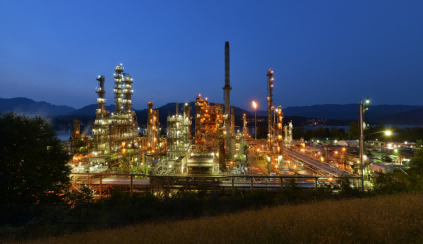
Diepoxides as High-Performance Demulsifiers in Oilfield Operations: Comprehensive Chemistry, Mechanisms, and Field Applications
1. Introduction to Oilfield Demulsifiers: Challenges and Solutions
In the petroleum industry, the extraction and processing of crude oil frequently result in the formation of complex water-in-oil (W/O) or oil-in-water (O/W) emulsions, which are stabilized by naturally occurring surfactants such as asphaltenes, resins, naphthenic acids, and fine solid particles (e.g., clays and iron sulfides). These emulsions create significant operational challenges, including increased fluid viscosity, pipeline corrosion, reduced heat exchanger efficiency, and higher transportation costs. Additionally, excessive water content in crude oil can lead to catalyst poisoning in refineries, necessitating stringent BS&W (Basic Sediment & Water) specifications, typically below 0.5% for pipeline-quality crude.
To address these issues, demulsifiers—specialized chemical compounds designed to destabilize emulsions—are widely employed in oilfield operations. These chemicals function by disrupting the interfacial film surrounding water droplets, promoting coalescence and phase separation. The effectiveness of a demulsifier depends on several factors, including molecular weight, hydrophile-lipophile balance (HLB), temperature stability, and compatibility with the crude oil’s chemical composition. Among the various classes of demulsifiers, diepoxides have emerged as a highly efficient option due to their unique reactivity, thermal stability, and adaptability to different crude types, particularly in heavy oil and high-TAN (Total Acid Number) environments.
2. Diepoxide-Based Demulsifiers: Chemistry and Structural Advantages
Diepoxides belong to a specialized category of epoxide-functionalized compounds, characterized by the presence of two reactive oxirane rings within their molecular structure. These compounds are typically synthesized via epoxidation of dienes, unsaturated fatty acids, or polyols, followed by copolymerization with ethylene oxide (EO) and propylene oxide (PO) to enhance their surfactant properties. The resulting polymers exhibit excellent interfacial activity, making them particularly effective in breaking stubborn crude oil emulsions.
Chemical Structure and Key Functional Properties
The generalized chemical structure of a diepoxide demulsifier can be represented as:

R₁, R₂, R₃ = Alkyl, aryl, or other functional groups that influence solubility and interfacial activity.
The epoxide rings serve as highly reactive sites, capable of undergoing ring-opening reactions with polar components (e.g., asphaltenes and carboxylic acids) in crude oil.
To optimize performance, diepoxide-based demulsifiers are often modified with polyether chains (EO/PO blocks), which enhance their hydrophilic-lipophilic balance (HLB) and improve dispersion in both aqueous and organic phases. Key advantages of diepoxide demulsifiers include:
Superior thermal stability (effective up to 150°C), making them suitable for steam-assisted heavy oil recovery (SAGD).
High salt tolerance, allowing use in offshore and high-salinity reservoirs.
Strong film-breaking capability, particularly in asphaltene-stabilized emulsions.
3. Applications of Diepoxide Demulsifiers in Oilfield Processing
Diepoxide-based demulsifiers are employed across multiple stages of crude oil treatment, each requiring tailored formulations to address specific emulsion challenges.
(a) Dehydration (Primary Water Separation)
Used in gravity separators and heater-treaters to remove free water from crude oil.
Particularly effective in heavy oil fields, where traditional demulsifiers fail due to high asphaltene content.
Optimal dosage: 50–150 ppm, depending on emulsion stability.
(b) Electrostatic Desalting (Refinery Pretreatment)
Applied in electrostatic desalters to enhance water droplet coalescence under an electric field.
Helps remove chlorides, sulfates, and metal ions, reducing corrosion risks in refining units.
Often blended with cationic surfactants to improve efficiency.
(c) Residual Water Removal (Final Drying Stage)
Used in chemical injection skids to achieve ultra-low BS&W (<0.3%) before pipeline transport.
Synergistic effects observed when combined with polymeric alkoxylates.
(d) Enhanced Oil Recovery (EOR) Applications
Injected into steam flood and SAGD operations to break viscous bitumen emulsions.
Helps reduce heat exchanger fouling in oil sands processing.
4. Operational Best Practices: Laboratory Testing and Field Implementation
(a) Bottle Testing (Bench-Scale Evaluation)
Before field deployment, diepoxide demulsifiers undergo rigorous bottle testing to assess performance:
Sample preparation: Crude oil is mixed with varying demulsifier concentrations (10–500 ppm).
Heating and agitation: Samples are heated to 60–90°C (simulating field conditions) and shaken to form emulsions.
Settling observation: Water separation efficiency is measured over 30–120 minutes.
(b) Field Injection Strategies
Continuous injection: Preferred for stable emulsions, with dosage adjusted based on real-time BS&W monitoring.
Batch treatment: Used in severe emulsion cases, where slugs of concentrated demulsifier are injected.
(c) Synergistic Formulations
Diepoxides are often blended with:
Alkylphenol-formaldehyde resins – For enhanced asphaltene dispersion.
Polyethyleneimines (PEI) – To improve electrostatic coalescence in desalters.
5. Market Pricing and Cost Optimization Strategies
The cost of diepoxide demulsifiers is influenced by:
Raw material prices (epichlorohydrin, ethylene oxide, etc.).
Degree of chemical modification (higher EO/PO content increases cost).
2025 Price Benchmarking
Diepoxide Supplier
UNPChemicals is a professional oilfield chemical manufacturer, with products covering drilling, completion, oil production, gathering and transportation, etc., and has won the trust of customers with advanced technology, strict quality control and high-quality services. We are committed to personalized solutions to help oilfields develop efficiently.